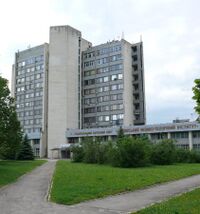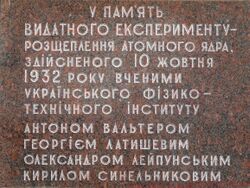Organization:Kharkiv Institute of Physics and Technology
The National Science Center Kharkiv Institute of Physics and Technology (KIPT) (Ukrainian: Національний науковий центр «Харківський фізико-технічний інститут»), formerly the Ukrainian Physics and Technology Institute (UPTI) is the oldest and largest physical science research centre in Ukraine .[1] Today it is known as a science center as it consists of several institutes that are part of the Kharkiv Institute of Physics and Technology science complex.
History
The institute was founded on 30 October 1928, by the Government of Soviet Ukraine[2] on an initiative of Abram Ioffe on the northern outskirts of Kharkiv (in khutir Piatykhatky) as the Ukrainian Institute of Physics and Technology for the purpose of research on nuclear physics and condensed matter physics.
From the moment of its creation, the institute was run by the People's Commissariat of Heavy Industry.
On 10 October 1932 the first experiments in nuclear fission in the Soviet Union were conducted here. The Soviet nuclear physicists Anton Valter, Georgiy Latyshev, Cyril Sinelnikov, and Aleksandr Leipunskii used a lithium atom nucleus. Later the Ukrainian Institute of Physics and Technology was able to obtain liquid hydrogen and helium. They also constructed the first triple coordinate radar station, and the institute became a pioneer of the Soviet high vacuum engineering which was developed into an industrial vacuum metallurgy.
During Stalin's Great Terror in 1938, the institute suffered the so-called UPTI Affair: three leading physicists of the Kharkiv Institute (Lev Landau, Yuri Rumer and Moisey Korets) were arrested by the Soviet secret police.[3]
The Ukrainian Institute of Physics and Technology was the "Laboratory no. 1" for nuclear physics, and was responsible for the first development of a nuclear bomb in the USSR.[citation needed]
It was damaged by shelling during the 2022 Russian invasion of Ukraine,[4][5] resulting in heavy damage to the Neutron Source nuclear facility.[6] [7]
Directors
- 1929 — 1933: Ivan Obreimov
- 1933 — 1934: Aleksandr Leipunskii
- 1934 — 1936: Semyon Davidovich
- 1936 — 1938: Aleksandr Leipunskii
- 1938 — 1941: Aleksandr Shpetny
- 1944 — 1965: Cyril Sinelnikov
- 1965 — 1980: Victor Ivanov
- 1980 — 1996: Viktor Zelensky
- 1996 — 2004: Vladimir Lapshin
- 2004 — 2017: Ivan Neklyudov
- 2017 — present: Nikolay Shulga
Important institutes
Science and education institutions in Pyatykhatky.
Kharkiv Institute of Physics and Technology
- The Lev Shubnikov Low Temperature Laboratory at the Ukrainian Institute of Physics and Technology was founded in 1931. Lev Shubnikov was a head of the cryogenic laboratory at the Ukrainian Physics and Technology Institute in 1931–1937. In 1935, Rjabinin, Schubnikow experimentally discovered the Type-II superconductors at the cryogenic laboratory at the institute.[8][9]
- Institute of condensed matter physics, materials studies and technology
- Plasma physics institute, Institute of high energy and nuclear physics
- Institute of plasma electronics and new methods of acceleration
- Akhiezer Institute of theoretical physics
Other institutes
- Kharkiv University faculty of physics and technology, located nearby.
Notable alumni
- Aleksander Akhiezer
- Naum Akhiezer
- Semion Braude
- Dmitri Ivanenko
- Fritz Houtermans
- Arnold Kosevich
- Eduard Kuraev
- Igor Kurchatov
- Lev Landau
- Oleg Lavrentiev
- Aleksandr Leipunskii
- Ilya Lifshitz
- Evgeny Lifshitz
- Boris Podolsky
- Isaak Pomeranchuk
- Antonina Prikhot'ko
- Lev Shubnikov
- Cyril Sinelnikov
- László Tisza
See also
- List of science centers
References
- ↑ "History | ННЦ ХФТИ". http://www.kipt.kharkov.ua/en/bhr.html.
- ↑ Taravarov, Ya. Landau in a field of negative values (Ландау в области отрицательных значений). Vokrug Sveta. 15 December 2008.
- ↑ (in Ukrainian) Landau, atom splitting and secret bunker. Yak in the crackdown of Stalinist repressions in Kharkiv they set up "Kremnіevu Valley", Ukrayinska Pravda (12 February 2021)
- ↑ Grant, Andrew (2022-03-07). "Prominent Ukrainian physics institute imperiled by Russian attacks" (in EN). Physics Today 2022 (2): 0307a. doi:10.1063/PT.6.2.20220307a. Bibcode: 2022PhT..2022b.307.. https://physicstoday.scitation.org/do/10.1063/PT.6.2.20220307a/abs/.
- ↑ "Russian Shelling Damaged a Nuclear Research Facility, Ukraine Says" (in en). https://www.vice.com/en/article/4aw5n9/russian-shelling-damaged-a-nuclear-research-facility-ukraine-says.
- ↑ "A future for Ukrainian science". Science. 13 June 2022. doi:10.1126/science.add4088. https://www.science.org/doi/10.1126/science.add4088.
- ↑ (in English) Update 125 – IAEA Director General Statement on Situation in Ukraine, International Atomic Energy Agency (11 November 2022)
- ↑ J. N. Rjabinin, L.W. Schubnikow, Magnetic properties and critical currents of superconducting alloys, Physikalische Zeitschrift der Sowjetunion, vol .7, no.1, pp. 122-125, 1935.
- ↑ J. N. Rjabinin, L.W. Schubnikow, Magnetic properties and critical currents of supra-conducting alloys, Nature, 135, no. 3415, pp. 581-582, 1935.
External links
- National Science Center, Kharkiv Institute of Physics and Technology
- Kharkiv Institute of Physics and Technology . National Academy of Sciences of Ukraine
[ ⚑ ] 50°05′24″N 36°15′00″E / 50.090°N 36.250°E
 |




